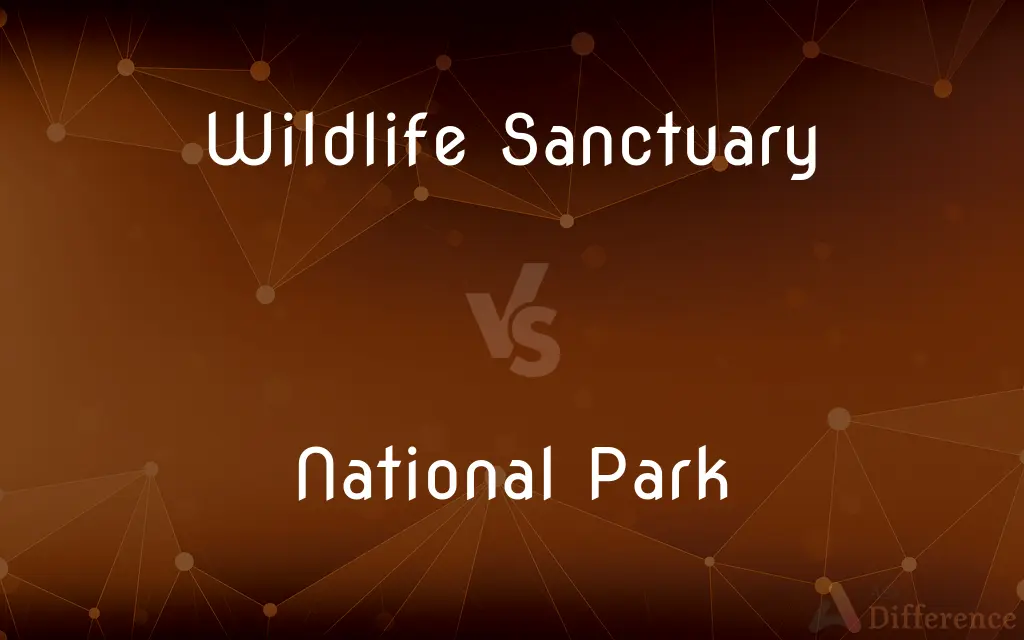Wildlife Sanctuary vs. National Park — What's the Difference?
Edited by Tayyaba Rehman — By Fiza Rafique — Published on December 22, 2023
A Wildlife Sanctuary is primarily focused on the protection of specific species, while a National Park conserves entire ecosystems and can include recreational areas.

Difference Between Wildlife Sanctuary and National Park
Table of Contents
ADVERTISEMENT
Key Differences
A Wildlife Sanctuary is an area set aside primarily for the protection of specific wildlife species, ensuring they have a conducive environment to thrive. A National Park, on the other hand, is designated to conserve a rich variety of ecosystems and includes both flora and fauna.
In a Wildlife Sanctuary, the main emphasis is on the conservation of particular animal or bird species. Human activities might be more restricted here than in a National Park, which often permits recreational activities like trekking, camping, and sightseeing.
Wildlife Sanctuary regulations often revolve around the specific needs of the species they aim to protect. Meanwhile, a National Park operates with a broader mandate, balancing both environmental conservation and human recreation.
Wildlife Sanctuaries often allow traditional activities of the indigenous communities, but these are regulated to ensure minimal disturbance to the protected species. In contrast, National Parks usually have stringent regulations, and only specific zones might be open to visitors.
While both Wildlife Sanctuaries and National Parks play pivotal roles in biodiversity conservation, their objectives and management strategies might differ. The former zeros in on species protection, while the latter manages an entire ecosystem, often accommodating tourists.
ADVERTISEMENT
Comparison Chart
Primary Focus
Protection of specific wildlife species
Conservation of entire ecosystems
Human Activities
More restricted, centered around species' welfare
Allows recreational activities in designated areas
Regulations
Tailored for the protection of particular species
Broader, balancing both conservation and recreation
Indigenous Communities
Traditional activities often allowed but regulated
Typically have stringent regulations with limited zones for human activity
Purpose
Species-focused conservation
Ecosystem-focused conservation with tourism potential
Compare with Definitions
Wildlife Sanctuary
A protected region where wildlife can thrive without human disturbances.
Tigers have seen a population resurgence in the Wildlife Sanctuary.
National Park
An area managed for conservation and public enjoyment.
Smoky Mountains National Park is popular for its autumn foliage.
Wildlife Sanctuary
Zone safeguarding particular species from external threats.
The Wildlife Sanctuary has strict regulations against logging.
National Park
A sanctuary for nature, often including historical or cultural sites.
The ancient ruins within the National Park attract historians.
Wildlife Sanctuary
A refuge ensuring a conducive environment for wildlife.
The Wildlife Sanctuary provides a natural habitat for the migratory birds.
National Park
A designated region preserving both flora and fauna.
The Grand Canyon National Park is a testament to nature's wonders.
Wildlife Sanctuary
An area reserved for the protection of specific wildlife.
The eagle is now thriving thanks to the local Wildlife Sanctuary.
National Park
A region set aside for environmental preservation and tourism.
Visiting the National Park was a refreshing experience.
Wildlife Sanctuary
A haven for endangered or vulnerable species.
Poaching reduced after the establishment of the Wildlife Sanctuary.
National Park
A protected area conserving biodiversity and allowing recreational activities.
Yellowstone is a famous National Park in the U.S.
Common Curiosities
Are all activities of indigenous communities restricted in a Wildlife Sanctuary?
Not always. While regulated, certain traditional activities of indigenous communities might be permitted in a Wildlife Sanctuary.
Can tourists visit a National Park for recreation?
Yes, National Parks often have designated areas for recreational activities like camping, trekking, and sightseeing.
Can a National Park house endangered species?
Yes, National Parks can and often do provide protection for endangered species within their ecosystems.
Are human activities restricted in a Wildlife Sanctuary?
Yes, human activities in a Wildlife Sanctuary are more restricted than in a National Park to ensure the welfare of protected species.
Is tourism a primary objective for a Wildlife Sanctuary?
No, the primary objective of a Wildlife Sanctuary is species protection. However, some might permit regulated tourism.
Can a Wildlife Sanctuary be upgraded to a National Park?
Yes, based on its significance, size, and purpose, a Wildlife Sanctuary can be designated as a National Park.
What's the primary focus of a Wildlife Sanctuary?
It focuses on the protection and conservation of specific wildlife species.
Which is larger, a Wildlife Sanctuary or a National Park?
Size varies, but generally, National Parks cover larger areas than Wildlife Sanctuaries.
Do National Parks play a role in cultural preservation?
Yes, some National Parks also preserve historical or cultural sites.
Which has stricter regulations, a Wildlife Sanctuary or a National Park?
Both can have stringent regulations, but typically, Wildlife Sanctuaries have stricter rules centered around species protection, while National Parks balance conservation and recreation.
Can commercial activities take place inside a National Park?
Generally, commercial activities are limited and regulated to ensure the conservation objectives of the National Park are met.
Can a species be relocated from a Wildlife Sanctuary to a National Park?
Yes, relocations can occur for various reasons, including habitat suitability, genetic diversity, or conservation strategies.
How does a National Park benefit the local community?
Beyond conservation, National Parks can boost local economies through tourism and provide recreational spaces for the public.
Are private vehicles allowed in a Wildlife Sanctuary?
Regulations vary, but typically, private vehicles might be restricted to ensure minimal disturbance to wildlife.
Are there any global networks or conventions supporting Wildlife Sanctuaries and National Parks?
Yes, organizations like UNESCO and IUCN play roles in designating and supporting protected areas worldwide.
Share Your Discovery

Previous Comparison
Gel Deodorant vs. Solid Deodorant
Next Comparison
Leaded Petrol vs. Unleaded PetrolAuthor Spotlight
Written by
Fiza RafiqueFiza Rafique is a skilled content writer at AskDifference.com, where she meticulously refines and enhances written pieces. Drawing from her vast editorial expertise, Fiza ensures clarity, accuracy, and precision in every article. Passionate about language, she continually seeks to elevate the quality of content for readers worldwide.
Edited by
Tayyaba RehmanTayyaba Rehman is a distinguished writer, currently serving as a primary contributor to askdifference.com. As a researcher in semantics and etymology, Tayyaba's passion for the complexity of languages and their distinctions has found a perfect home on the platform. Tayyaba delves into the intricacies of language, distinguishing between commonly confused words and phrases, thereby providing clarity for readers worldwide.












































